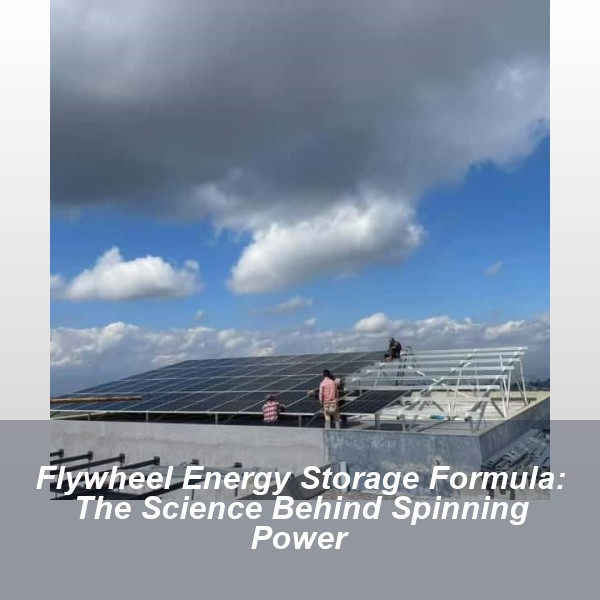Flywheel Energy Storage Formula: The Science Behind Spinning Power

Why Your Next Battery Might Be a Spinning Metal Disc
Ever wondered how Formula 1 cars recover braking energy so efficiently? The secret lies in the flywheel energy storage formula - a physics marvel that's powering everything from data centers to amusement parks. Let's crack open this rotational mystery like a walnut (but with less mess and more kinetic joy).
The Nuts and Bolts of Flywheel Physics
At its core, the flywheel energy storage formula is deceptively simple:
- E = ½ Iω² (where E=energy, I=rotational inertia, ω=angular velocity)
- I = kMR² (k=geometry factor, M=mass, R=radius)
But these equations hide more secrets than a magician's hat. The real magic happens when you realize doubling the rotation speed quadruples the stored energy - which is why modern flywheels spin faster than your blender on steroids (up to 50,000 RPM!).
Engineering's New Spin on Old Physics
Recent advancements have transformed this 19th-century concept into 21st-century wizardry:
- Carbon fiber composites with 10x the strength-to-weight ratio of steel
- Magnetic bearings that reduce friction to near-zero levels
- Vacuum chambers that could make a black hole jealous
A real-world example? NASA's ISS replacement batteries use flywheels that store enough energy to power 12 homes for an hour - all in a unit smaller than a washing machine.
When Formulas Meet Reality: Case Studies That Spin Right Round
The Roller Coaster That Pays Its Electric Bill
Six Flags New England's "Superman Ride of Steel" uses regenerative braking flywheels that:
- Recover 60% of braking energy
- Save 900,000 kWh annually - enough to power 85 homes
- Reduce peak demand charges by 40%
Talk about an energy loop-de-loop!
Data Centers That Never Skip a Beat
Tech giants are swapping chemical batteries for flywheel UPS systems that:
- Respond in 2 milliseconds (50x faster than lead-acid batteries)
- Last 20+ years with zero performance degradation
- Operate in temperatures that would fry traditional batteries
Microsoft's Dublin data center uses 200-ton steel flywheels that could keep 10,000 servers running during brief outages - essentially giving power failures the cold shoulder.
The Formula's Hidden Variables: What Most Engineers Miss
While everyone focuses on the flywheel energy storage formula itself, smart designers know three secret ingredients:
- Geometry Factor (k): 1 for thin rings, 0.5 for solid discs - choose wisely!
- Angular Acceleration: The real MVP in frequency regulation markets
- Energy Ripple: Keep it under 5% or risk becoming the DJ of power fluctuations
Beacon Power's 20 MW frequency regulation plant in New York uses these principles to balance grid power better than a tightrope walker with a physics degree.
When Numbers Meet Nature: The Hummingbird Paradox
Here's where it gets wild - the flywheel energy storage formula explains why hummingbirds hover more efficiently than helicopters. Their wings act like biological flywheels, storing kinetic energy during each flap cycle. Engineers are now mimicking this design in micro-flywheels for medical implants. Nature's been spinning this solution for millennia - we're just catching up!
Future Spin: Where Rotational Storage Meets Quantum Leaps
The latest R&D is turning the flywheel energy storage formula into a playground for mad scientists:
- Room-temperature superconducting bearings (goodbye, friction!)
- 3D-printed gyroid structures with 95% air content
- AI-optimized geometry that makes Fibonacci sequences look basic
ARPA-E's $43 million DAYS program recently demonstrated flywheels that can store energy for 100 hours - long enough to make traditional batteries question their career choices.
The Coffee Cup Test: A Practical Formula Hack
Next time you stir coffee, watch the vortex form. That's essentially a liquid flywheel storing energy through rotational motion. Engineers at MIT scaled this concept to create liquid metal flywheels that:
- Achieve energy densities comparable to lithium-ion batteries
- Cost 60% less than solid rotor systems
- Can be "recharged" simply by adding more molten metal
It's like having your energy storage and drink it too - minus the caffeine jitters.
- Pre: Energy Storage Power Converters: The Unsung Heroes of Modern Power Systems
- Next: Pattern Energy's Energy Storage Playbook: Powering Tomorrow's Grid Today
Related Contents

Flywheel Energy Storage Operation: Harnessing Spinning Power for Modern Energy Needs
Ever wondered what giant spinning metal wheels have to do with keeping your smartphone charged? Let me paint you a picture: imagine a 10-ton steel disc rotating at 16,000 RPM in a vacuum chamber - that's flywheel energy storage operation in action. Unlike chemical batteries that store juice through reactions, these mechanical beasts bank energy through pure rotational momentum. Cool, right?

F1 Flywheel Energy Storage: The Secret Behind Racing's Power Boost
Ever wondered how Formula 1 cars recover energy at 200 mph without carrying bulky batteries? Let’s face it – F1 flywheel energy storage isn’t exactly dinner table conversation, but this spinning marvel has been quietly revolutionizing motorsport since 2009. From hairpin turns to pit lane strategies, this tech does for race cars what espresso shots do for sleep-deprived engineers.

Flywheel Energy Storage for Off-Grid Systems: The Spinning Solution to Power Independence
Imagine your Tesla Powerwall decided to moonlight as a ballet dancer - that's essentially what flywheel energy storage off grid systems bring to the renewable energy party. As more homeowners and remote facilities ditch traditional power grids, these mechanical marvels are spinning their way into the spotlight. Let's explore why this 19th-century technology is experiencing a 21st-century renaissance.
